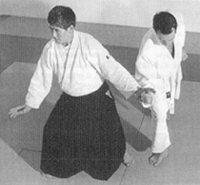 |
Tai-sabaki// Источник: B.A.F. Newsletter, Март 1998, No 29
In "An Introduction to Aikido" by the Doshu, Kisshomaru Ueshiba we read: "The most characteristic movements of Aikido are irimi and sabaki. Sabaki is similar to the movement of a spinning top. This means that the movement has its centre, and you sabaku your body by moving your centre. Furthermore, this movement should be made with independence. The movement makes a sphere. No mailer from which side you have been attacked, the movement should be round and smooth. "When we think about the sabaki of Aikido, we can regard the body as an elaborate machine. That's to say, when the big toe turns to the left, all parts of the body move in harmony with it. Any part of the body cannot move irrespective of the rest of the body. The body is in harmony. "With this sabaki you can absorb your partner into the sphere of your movement, or you can act like a spinning top that flings off what has touched it."
Irimi means literally 'entering body'. This is a movement perhaps unique to Aikido. In his book Aikido Doshu describes it as an 'art' applied during the moment of your opponent's attack, moving out of his line of attack to his 'dead' side. In fact, the principle of irimi (entering) is basic to most movements in Aikido. Tenkan means 'change', 'turn bout and this we can interpret in the Aikido context as changing our direction, turning the body in response to an attack, avoiding it and absorbing the assailant's aggressive force. Both irimi and tenkan can be combined with ashi ('foot', 'step') to make the terms irimi-ashi ('moving forwards') and tenkan-ashi ('pivoting'). Kaiten means 'rotation', hence kaiten-nage, 'rotary throw'. Then there is uchi-kaiten - 'inner' rotation and soto-kaiien - 'outer rotation'. // Из одного из последующих Newsletter
|
|||
| © Рюсинкан.ру |

 In books on Aikido in English the term
In books on Aikido in English the term